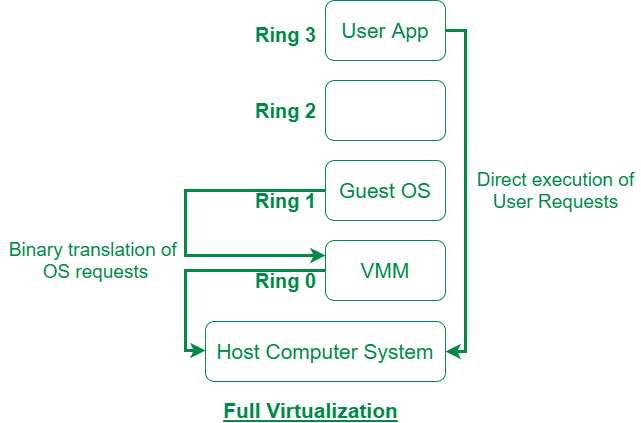1.全虚拟化:
全虚拟化于 1966 年由 IBM 推出。它是服务器虚拟化的第一个软件解决方案,使用二进制翻译和直接方法技术。在完全虚拟化中,来宾操作系统被虚拟机与虚拟化层和硬件完全隔离。 Microsoft 和 Parallels 系统是完全虚拟化的示例。

2. 半虚拟化:
半虚拟化是 CPU 虚拟化的类别,它使用超级调用进行操作以在编译时处理指令。在半虚拟化中,来宾操作系统不是完全隔离的,而是由虚拟机与虚拟化层和硬件部分隔离的。 VMware 和 Xen 是半虚拟化的一些例子。

全虚拟化和半虚拟化的区别如下:
| S.No. | Full Virtualization | Paravirtualization |
|---|---|---|
| 1. | In Full virtualization, virtual machine permit the execution of the instructions with running of unmodified OS in an entire isolated way. | In paravirtualization, virtual machine does not implement full isolation of OS but rather provides a different API which is utilized when OS is subjected to alteration. |
| 2. | Full Virtualization is less secure. | While the Paravirtualization is more secure than the Full Virtualization. |
| 3. | Full Virtualization uses binary translation and direct approach as a technique for operations. | While Paravirtualization uses hypercalls at compile time for operations. |
| 4. | Full Virtualization is slow than paravirtualization in operation. | Paravirtualization is faster in operation as compared to full virtualization. |
| 5. | Full Virtualization is more portable and compatible. | Paravirtualization is less portable and compatible. |
| 6. | Examples of full virtualization are Microsoft and Parallels systems. | Examples of paravirtualization are VMware and Xen. |